#set in a universe like the expanse or mass effect etc I would DIE for this game. it would be an instant favorite
Explore tagged Tumblr posts
Text



Started playing Heaven's Vault today... I LOVE this game and I LOVE Aliya, she is such a shithead in all my favorite ways
#heaven's vault#aliya elasra#this game is soooo good so far. I love the language system#but also the animation gives me a little bit of a headache#and I wish it was like... harder sci-fi?#set in a universe like the expanse or mass effect etc I would DIE for this game. it would be an instant favorite#and I do really like the unique shit it has going on so far. the treasure planet-esque interplanetary sailing is great#it's just not like. a vibe I would actively seek I think#I want like an honest-to-god spaceship y'know#like. this exact character and these exact systems would work soooooo well in my sci-fi universe and I am huge eyes emoji at all of this
47 notes
·
View notes
Note
What is your opinion of KOTOR 2? Favorite things about it, least favorite things about it, characters, etc.
Alright, it’s time for another video game review, so an early reminder, spoilers abound for both KOTOR1 and KOTOR2. There’s a cut of course. Overall, I thought it was a phenomenally well-written game and one of the greatest pieces of media to exist in the Stars Wars universe (although I haven’t read any of the Expanded Universe books so keep that in mind), and as is the usual case for Obsidian particularly in this era, developer constraints created a beautiful mess.
Before we can talk about KOTOR we need to talk a little bit about Star Wars and what it meant as a film. The original Star Wars isn’t a very creative story, it’s largely a conventional Hero’s Journey. It’s a pastiche of early adventure stories in a science fiction setting, but with the added benefit of video and sound effects to really make it come to life in a way that was only possible in the imagination of readers. This gave the series a wide deal of appeal. Folks who grew up on the 1950′s Flash Gordon serials or WW2 dogfight films could see a film with those things they loved from their childhood with a high budget to bring those things to life. Science fiction fans could visually see elements of their favorite books brought to life on the silver screen. Fans of movies can appreciate the cutting-edge (for the time, although I love me some practical effects in film) effects and the unfamiliar elements of science fiction with the familiar trappings of an adventure tale.
KOTOR was something similar for the video game industry, particularly for the fans of Baldur’s Gate. The ability to create a Jedi character and go on a journey like the Bhaalspawn did in Baldur’s Gate was something that appealed to a significant number of RPG fans, and the critical success of the Baldur’s Gate series brought a lot of money and prestige to Bioware. Fans of RPGs and Star Wars got to see their medium and interact with it in a whole new light. Much like A New Hope, KOTOR1 was largely a traditional story where Darth Malak is an evil guy without much in the way of redemptive qualities. The two major wrinkles were that you could play as a Sith and have some moments of true player cruelty like ordering Zaalbar to kill Mission, but this makes sense for an RPG, having no player choice in a game really makes you lose the lightside/darkside dynamic. Of course, the bigger and more interesting drift from a traditional Star Wars story was the Revan twist. This took advantage of both the slower pace of games to spend time with your PC and form a connection, and the nature of Western RPG’s where the player envisions themselves partially as their avatar onscreen to make the reveal hit home. Ultimately though, the Star Wars morality was upheld. The Jedi were the unequivocal good guys, the Sith were the unequivocal bad guys.
KOTOR2 decided to put the Force under the microscope. It had started in 2003, so Episode II had already come out, and this idea of the prophecy of Anakin bringing balance to the Force, and what we knew of the Jedi in the original Star Wars trilogy who were reduced to hermits hiding on the fringes of society, really gave the impetus to examine this idea of the balance of the Force as not necessarily benevolent. It’s not evil, per say, it’s just indifferent to the people that die to make it happen. So the game became a self-critical examination of the core structures of the Star Wars universe. The Sith are usually thought of as the bad guys, and a lot of that holds true, domination, subjugation, power, betrayal, all that nasty stuff aren’t really conducive to most conceptions of goodness, but are the Jedi good? Does their passivity lead to injustice and terror being wrought on others because the Jedi failed to act. That was the question behind the Jedi involvement in the Mandalorian Wars, was the Exile correct in going off to fight them or were the Jedi Council who forbade them correct? As befits the folks who wrote Planescape: Torment, the game has two journeys, one through the game world and the plot that unfolds and another more deeply introspective.
I’ll put the things I don’t like about KOTOR2 first because the list is small but it is worth noting. The game is very clearly a rushed product and it shows. The cut content shows a great deal of lost potential, and the bugs could make the game at times completely unplayable. The game suffered from the accelerated development, having barely half the development time, and you can see where the seams show. The UI is clunky and gets cluttered when you have to manage items. Level design is similarly a nuisance, as they are big sprawling expanses without a lot of content in them. Part of that is a necessity to the mechanics, smaller levels would have other encounter designs being agro’d into it, but the levels are still expansive, empty, and a slog to get through. The Peragus mining facility is too large by half, and there’s a lot of backtracking in these levels. Since side quests encourage finding a doodad or killing a few key figures scattered around a map, that means a lot of trekking through these big levels to find one particular item or enemy locked in a corner somewhere. That can be very tedious, particularly on repeat playthroughs. At times, it feels like legging your way through a swamp to get to the next piece of delicious content.
Which is a good segue into talking what I like about the game, because its writing and characters are superb. The character companions are twists of classic Star Wars archetypes. Atton is the scoundrel Han Solo non-Force user type, but ends up having a disturbingly dark backstory where he was a Sith interrogator and feared his own Force-sensitive nature. Bao-Dur is a man haunted by the weapon of mass destruction he created, a tech-head who ends up hating his most momentous creation but feels the need to use it yet again. Canderous has become the new Mandalore and is desperately trying to revitalize his dying culture because he’s been so broken by Revan’s departure. The Wookie life-debt is so toxic that it breaks Hanharr and Mira in their own ways. Visas is a Sith whose will is shattered. Each of these characters are fundamentally broken (save for the droids, unless you count the physical need to reassemble HK-47 as broken), and the Exile draws them to him or her. Through discovering more about them and resolving it, the Exile awakens the characters’ connection to the Force, oddly ironic since the Exile is cut off from the Force and is only rediscovering it. Like most Bioware RPG’s, you the player through your character guide the growth of these characters and form a relationship with them, or use them for your own ends.
Kreia, of course, deserves her own paragraph. Kreia is the Star Wars Ravel Puzzlewell, an embittered woman who wants to destroy the cosmic chains of the universe and loves the player character in a deeply obsessive way, one that’s played completely straight in how it makes the player uncomfortable. She is deeply resentful of the Force and wants to destroy it, and through the Exile, who managed to cut themselves off so utterly completely in a unique way, she sees the path. Of course, the reason why the Exile cut themselves off was the mass death at Malachor V was so overwhelming that he or she would have otherwise died. Of course, her obsession and overriding mission cares little for the Exile’s own pain, and so the manipulations begin, using you to lure out and destroy the Jedi and the Sith, and in the end, you disappoint her, either because you don’t learn her lessons or she discovers that the only reason you were the way you were was because you were afraid. She still is obsessed over you, though, and so when you finally confront her, she obliges that affection to explain everything, unusually honest for a woman whose Sith name is evocative of the word betrayal. And fortunately, she allows something that most monologue villains don’t allow, a means by which to tell her she’s full of shit. Certainly, it’s a little weaker coming from her as an option to you rather than the player character saying it themselves, but I think it’s stronger, since so much of the ending had to be cut anyway it reinforces the ambiguity of it, that the ending is what you believe. Personal belief has always been important for the Exile and Kreia/Traya, and letting that transfer to the player is, while perhaps not the most ideal, completely valid given how rushed the development was.
The other Sith Lords are fascinating concepts of evil and personal belief as well as well, and really show the Dark Side of the force in a parasitic, corrupt sense and the horrible ends of taking belief to its extreme. Darth Sion is the Lord of Pain. He cannot die but he feels pain constantly, making eternal life not a blessing but a torture, though in it he found a twisted source of enlightenment. His pain fuels his anger and hatred (key ingredients of the Dark Side) and so he persists solely through the Dark Side. Darth Nihilus, on the other hand, had his body obliterated by the Mass Shadow Generator, and so persisted as a wound in the Force, consuming Force energy to feed his relentless hunger. He is not a human anymore but a force of endless consumption that cannot be satiated, this hunger pain pushes him past his own mortal existence but which can only consume, not live. This perfectly illustrates the Dark Side concept of pursuit of power even past the point of sustainability, for Nihilus will continue consuming until all existence has been eaten.
The game is dark and moody, as you explore a shattered galaxy. In the original game, the search led to the Star Forge and the revelation that you the player was Revan. The sequel shows that there was no grand conspiracy; the act of Malachor built Nihilus and Sion and the player themselves was something that you did. It was not a conspiracy of Jedi but rather the after-effects of a particular action, much the way Lonesome Road had the Courier’s delivery of the package to Hopeville to be something that destroyed Ulysses even though you never met him. The Mass Shadow Generator was meant to save the galaxy from the Mandalorians but birthed a new, more powerful tragedy. Bao-Dur even wonders if the subjugation of the people under the Mandalorians was better than the power of the Mass Shadow Generator, a powerful moment ordered by just a mere single Jedi, built by a mere tech specialist. In true Planescape fashion, a personal apocalypse is a galactic apocalypse and vice-versa. Torment lingers over this game, in the broken characters, in a parallel journey both outward and inward. In many ways KOTOR2 was Planescape: Torment in the Star Wars universe, albeit with its own personal flair.
Alright, that’s a good review. I can do character analyses of some of the major characters if you want.
Thanks for the question, Messanger.
22 notes
·
View notes
Text
War, PTSD, and Role Play
So this might come off as ranty, for which I apologize.
Now, is it just me or is everyone rather desensitized to the fact that the warcraft universe is at war? More importantly, at war with some really terrifying shit? I get it, every expansion is a war. It’s that kind of game of course. World of Warcraft. But does that mean everyone is simply indifferent to the effects of such?
Admittedly, I’ve never actually been to war. And I’d like to preface all of this with a heart felt thank you to those of you who have been and what you’ve done for your respective countries. I’m also not oblivious to the fact that many soldiers come back from their deployment different. Veteran PTSD is a thing after all. Many soldiers go off to war and come back changed men and women. That kind of life is something many of us can’t imagine. On the flip side, many others come back fine. I don’t know the statistics. But we all know it happens.
So then there’s the role players in the warcraft universe. many of us (myself included) have played, or currently play, a character who has participated in different campaigns throughout warcraft history. Second & Third war, Outland, Northrend, Cataclysm, etc. Argus now being the most recent installment. and one thing I’ve noticed is many people seem to treat these events rather...casually.
There’s a few points I want to address about the scope of the world, some of these events and what it means to really participate in them. These are things I feel people don’t take into consideration. In the end RP your way. But perhaps consider this food for thought?
1) The Distance. This is something that is incredibly skewed due to the need to make the game at all playable. But I think a lot of people don’t realize how massive Azeroth (and the universe) is supposed to be. Dalaran has apparently 3000 citizens living in it. But it certainly doesn’t look like it could hold 3000 individuals in it. Elwynn is something like half a day to a days ride from Stormwind (Need source). Northrend, Kalimdor, Pandaria, entirely different continents. Consider how long it takes to fly to Europe from North America. Consider how long it takes to go by ship (which is warcrafts primary methods of mass travel). that’s potential weeks, if not months. but of course we have to cut corners here and there. Because this isn’t real life, it’s role play. But distance still needs to be considered. and it appears as though people don’t factor that in. It’s very much “oh I’m going to Plaguelands be back in half an hour” mentality as opposed too “I ride for Westfall in the morning. I’ll be back by weeks end” which, personally, cheapens the experience.
2) The enemy. With the exception of Vanilla and possibly Pandaria. We rarely fought a war against ‘normal’ threats (or each other in the PvP sense). We’ve fought insects, demons, old gods, undead, rampaging elementals, dragon aspects, literal feeling monsters, more demons, etc. If a soldier can go off to war on another continent and come back incredibly changed because of fighting other people. How terribly might someone be ruined by fighting the undead? Or demons? Or a literal god? I personally can’t fathom what that would do to a person because it’s fantasy. But I consider it in my RP as a Veteran character. Do I think fighting against demons, knowing what they do to people will fuck someone up? Hell yes I do. Imagine fighting in another country and watching your comrades get torn apart by attack dogs, or eaten by the enemy soldiers. That’s what we’re fighting on Argus. Just with cartoony graphics.
3) What it means to be a soldier. Here’s one I think a lot of people either don’t consider, or possibly choose to ignore because of how it does potentially hinder RP. But if you’re on duty, you don’t get to come home every night. You’re camped out at a Base of some sort. Whether that base camp is a fort in the middle east, or a spaceship on another planet. If you’re a soldier or mercenary of some organization you’re expected to be present for that period of time. You’re expected to sleep there, eat there, be ready for a counter attack at a moments notice. If you’re going home every night that base is left weakened. Each time you leave, you weaken that foothold and increase the chances that when you come back it will be overrun. My very very first RP campaign ever we were told that IC we’d be gone for a couple weeks. So we couldn’t really be seen in the city. Yes I appreciate that you want to go to the taverns and do walk up RP. But personally, if you want to play a character who’s going to participate in a war. commit to it. You’re not going to your job at the bank for 8 hours and coming home. You’re a soldier.
4) Portals. Mother trucking portals. Now remember this is me here, lore asshole who loooooves magic. Portals are my bread and butter. hearthstones, city portals, demonic gateways. They make getting around point 1) very easy without just using the compression of the game for granted. But it’s all to easy to abuse them in a war setting. “Well there’s a portal to Dalaran right there so like... I can just come and go as I please!” Yes. You have that ability for mechanical purposes of course. I.e. Blizz can’t lock us on Argus for the rest of the expansion. But refer to points 1-3. It will take time to travel from say, the Antoran Wastes to a transporter pad. A few hours at least maybe? Then When you come out in Dalaran. Maybe another 30 minutes to travel through the city to the stormwind portal? this list could get long but you see my point. And you can’t have a portal from your front door to the battlefield. That’s just inviting enemy forces right into your home. Portals, to me, always seem like the part of gameplay where realism and critical thinking is never used and people only think of the superficial uses and never the consequences or meaning behind their actions.
There are other lesser things to consider but these are the ones that I either focus on when I write, or I feel people abuse/don’t consider. When you say you’re fighting on Argus but come home every night and just wash the Fel away It cheapens the gravity of what were involving ourselves in, in my opinion. I get it, you don’t want to miss out on attending this weeks server social because you’re RPing being at war. No one is going to ask you too. It’s your game after all.
I can admit I’m personally annoyed by this, specifically because I find in trying to write someone with some Post Argus PTSD I’m met with a LOT of “oh pfft yeah I was on Argus too so what?” mentality and it bugs the shit out of me. I like to believe our soldiers here in reality don’t treat their brothers-in-arms like that. I’m not saying you should agree with them or give them a free pass when they do fucked up shit. Jump on them when it’s deserved. But please don’t discredit their actions in a war setting just because you take it less seriously than someone else. To me, that’s like a soldier looking at someone with PTSD and going “pfft it wasn’t that bad.” which, when you think of it in real world context, sounds pretty awful.
Now don’t take this as me telling you what to do or how to RP. Your money, your choice. Just in the same way it’s my money for my game. You can consider these points, Ignore them, If you have interesting counter points please share them! Like I said, it’s ranty and I apologize for that. If you want to be a casual player that’s your right of course, just like PvP and PvE, you don’t have to be a die hard. Play how you want.
Here’s a gif of a duck

124 notes
·
View notes
Text
Mass Effect Andromeda Review
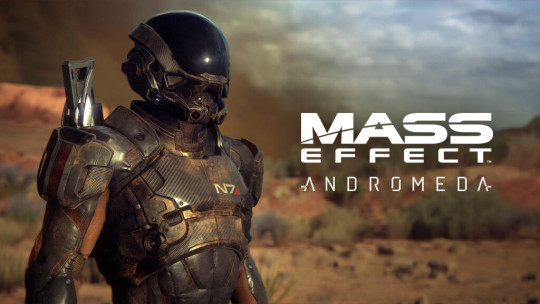
The Mass Effect series is one of the most revered and respected gaming brands ever released. The world building, strong characters, paralysing loss of loved characters and story moments that are iconic left a real imprint on the gaming industry. Unfortunately many people choose to remember the ending of the third game, which marred the franchise. Bioware went away for 5 years to deliver a new beginning, loosely linked with the trilogy and set in the Andromeda galaxy.

You play as Sara or Scott Ryder, brother and sister, who are part of the human ark. This ark has been sent on the 600 year journey to the Andromeda universe in search of a new world. The humans are not alone in their journey, as the Turians, Asari and Salarians have also sent arks into Andromeda. Krogans have also made the trip as well as dozens of individuals who went earlier to establish a home base known as the Nexus (think Citdadel). Of course, when you awake as either Sara or Scott, shit has definitely hit the fan, as a giant space phenomenon has crashed through the ark, causing malfunction and your sibling to be put into a long coma. Your job as the Pathfinder’s daughter or son is to check out the first potential home world known as Habitat 7.
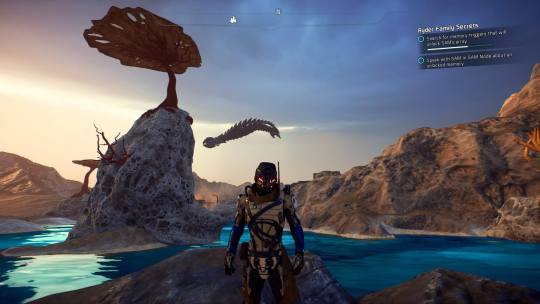
While this all sounds very safe and very familiar, it does establish Sara (I played as Sara and haven’t as Scott) as an interesting character that has a variation of approaches. Removed is the renegade and paragon options. This allows much more freedom, rather than committing to one approach, even though you may not agree with all the actions. You are free to make decisions as your character based on how you want them to react to that particular situation. After a terrible incident on Habitat 7, which sees your father killed saving your life, you inherit the prestigious role as the Pathfinder, in charge of finding a new world for the human race to live. This is a huge job and involves difficult choices, putting up with the new galaxy’s politics and also fighting the new enemy and new alien race, the Kett.
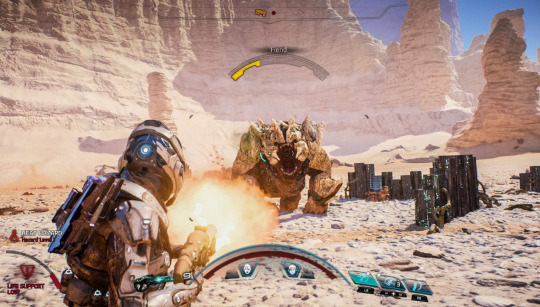
As the story continues, there are a number of interesting twists and turns, that introduces new characters to join your squad and offer loyalty missions, similar to Mass Effect 2. While the loyalty missions hold the same purpose, there is no real consequence to not following them through like in the second game, where you would see characters die as a result. The loyalty missions were the best part of the second game, as they gave you a reason to delve deep into your squads history and personal lives. While there are some examples of this in Andromeda, I found the loyalty missions to be very, very, very long and drawn out. They are designed to continue over the course of the entire game. This time around, Andromeda is a 50-70 hour game. I spent 57 hours in the game before I reached the ending credits, still giving 3-4 major side quests unfinished. That was main story, exploration and loyalty missions padding that time out (also a good 3-4 hours of loading I presume). The loyalty missions in Andromeda do boil down again to doing a specific tasks that links and helps a certain character. They can get very fetch quests heavy and in some stages of a few loyalty missions it becomes a planet hopping slog, that got very old and tedious. It still pushes you through as some of the story moments that occur are fantastic.
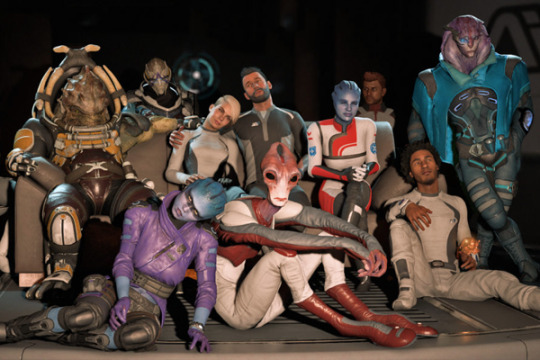
Your squad again consists of a range of characters with unique outlooks and motivations. Drack, an, old battle scarred Krogan that has fought in many wars and is here in support of his daughter Kesh. Cora, a human who is obsessed (it is unhealthy) with the Asari and saving the Asari Ark. Liam, another human who is in support of the Andromeda initiative and colonising the many planets around Andromeda. Vetra, A turian try hard female Garrus who simply is not as good at calibrating things. Peebee, a quirky Asari, with a big personality who is keen to research and learn about the ancient technology of the Remnant that becomes a big part of the story and why the planets and galaxy are the way they are. Lastly is Jaal, who is a mix of Thane and Garrus from the original trilogy. Jaal is the 1 major new species introduced in the game, other than the kett. The Kadara are a large, unique looking alien that are very spiritual and present the most interesting moments in the game. Jaal is a warrior, who sticks to his beliefs and is interested in learning more about the Milky Way galaxy and why we have come to Andromeda. The cast of characters, are strong, however nothing will compare to the original trilogy’s squad. It puts Andromeda on the back foot straight away.
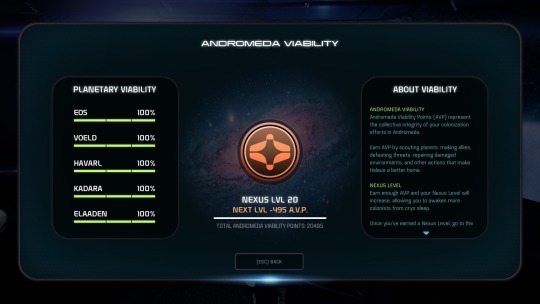
One major positive of the Andromeda is how open to exploration and discovery the universe is. There are 7 major planets that can be explored and made a viable living space. Every action completed on a planet increases the percentage that the planet is viable. Side quests, clearing hostile wild life, helping the locals with collecting materials and discovery special locations known as Remnant vaults lead to setting up an outposts, which again leads to even more activities and quests. The Remnant vaults are the key to making each planet liveable. This is presented early in the game and completing the Dungeons (vaults) allow the planet to remove the factor that is currently making them uninhabitable. This is explained throughout the story as your progress. Planets that are too hot, too cold, covered in radiation, have electrified water and so on can be repaired by completing the dungeon like vaults. Inside each vault are a number of puzzles that can be solved with the game’s new movement system allowing dashing, jumping and side stepping with a booster pack or simple logic and combat puzzles. The Vaults never out stay their welcome and always offer an interesting and unique gameplay experience that then make life on each of the planets much easier.
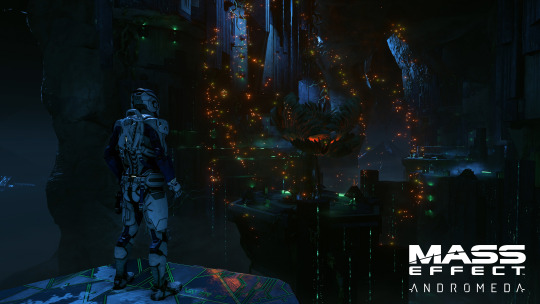
As you are working your way through the planets you are going to be engaging in a lot of combat. Way more than the original trilogy. The combat though is very tight and responsive. It may be the best part of the game as every combat scenario is a good mix of challenging and satisfying. The Kett are a pretty standard enemy and will attack you in traditional Mass Effect nature. Hiding behind cover, making use of the environment, flanking and firing off a number of powers challenges you to think quickly, bring the right squad mates and also be mindful when picking your loadouts. The system has changed in Andromeda in which you are no longer locked to choosing and upgrading skills that link to a specific class type. In previous games you were stuck upgrading skills that linked to a soldier, vanguard, sentinel etc. However Andromeda allows you to pick and choose your skills, upgrade them how you see fit and swap them on the fly. If you are struggling in the middle of a challenging fight against a bunch of enemies that have armour, you can upgrade something like incinerate that destroys armour. Struggling against shielded enemies, then upgraded overload or singularity. It really allows a great diversity in every combat situation and ensures that everyone playing the game is going to have a different approach to enemy encounters. As you put upgrade points into your preferred skills you will unlock class types that have particular buffs and skill enhancements based on the upgrades you are using. The more points, the better the class types become. These can also be changed at will from the menus.
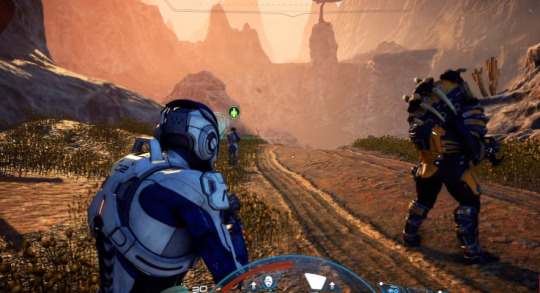
Weapons are also very come and go in Andromeda. Mass Effect 3 really slowed down the customisation of weapons and armour, however the huge and expansive crafting system in Andromeda allows a large range of weapons to be crafted and customised to your liking. First you will have to find the resources by planet scanning or mining using the Nomad (yay it’s back) when you are on the many planet’s surface. After which, you can return to your crafting bay on your new ship the Tempest. There are so many variations of weapons that can be built and as you acquire mods and other upgrades weapons can be adapted to buff whatever suits your playing style. The game gives you a lot to play with and tinker with as you advance. Not only can you tinker with all of your skills, classes and weapons, but you can customise your rewards, strike teams and more. These strike teams link to the multiplayer, which returns in similar fashion from the third game. Wave based combat in a group against enemy AI is a fun side challenge and again very rewarding when playing with a group of friends. The strike teams can earn rewards in the single player which unlock minerals for crafting and even weapon modes. These can be completed by your strike teams, which Ryder can organise from her main hub. AVP missions are unlocked as you advance the plot and can impact experience boosts or delivery of goods and rewards.
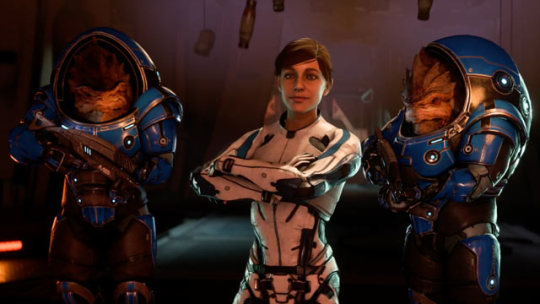
Andromeda is a deep game with a lot of systems. While they don’t always present themselves in a way that makes sense, it does give you a lot of variation with how the game plays. Unfortunately combat is the primary way most situations are solved. There doesn’t really ever feel like there is a viable workaround in challenging situations where Ryder must make a choice that doesn’t result in violence. Often Ryder will shoot first and ask questions later. There are also not as many memorable choices throughout the game. There are a number of interesting options that at the time seem like they will impact something later on, however most never eventuate. This makes me wonder whether they were intended to be answered or featured in a sequel, a sequel we may never get after negative reviews, bugs, glitches and general negative word of mouth.
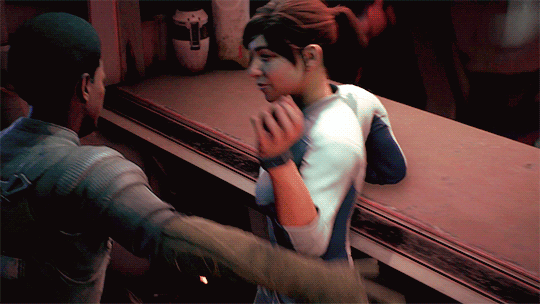
Despite the gifs, news stories etc. surfacing about the game’s buggy and glitchy nature. I didn’t really encounter any problems. Considering this is a 70 hour, open world RPG, people have seemingly forgotten how hard it is to bug test games of this nature. We gave Fallout 4 a pass remmeber. The dialogue, facial animation and character issues have been resolved with the many post release patches and as a result give the game a much more polished feel. Clearly EA needed this game out and didn’t feel like delaying it until May. If they did, the game may have been much more successful away from Horizon, the release of the Switch and Zelda. A more rounded, polished experience in a quieter month, may have been what this game needed.

I loved playing Mass Effect Andromeda. The game presented so many fantastic combat scenarios, plenty of laughs from the engaging cast of characters and plenty of surprises when exploring the massive plants. While the story was familiar, safe and often nonsensical, I enjoyed the ride that it presented. The game leaves a lot of questions unanswered and is clearly meant to be the start of a new franchise and I really hope we see the second game at some stage.
8.5/10
Reviewed on Xbox One.
4 notes
·
View notes